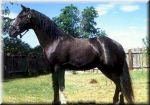How to Trim a Horse
Rebecca Colnar
Wild horses grow long, protective coats that shed naturally,
governed by the change of seasons. Domesticated horses also shed
their coats on a seasonal basis if they are pastured outside for
most of the year -- this is fine and natural.
Leaving a long coat on a horse that is stabled in warm quarters
or one that is frequently ridden hard can cause problems,
however. For example, a hairy horse will not dry quickly and
properly in cold weather.
Before you grab the clippers, know the grooming and clipping best
suited for your type of horse.
For example, a horse ridden on a regular basis in a warm climate
has different needs from one stabled or pastured where the
temperature plummets in winter.
How the horse is used is also a factor. The owner of the show
horse must know the correct grooming, clipping and etiquette for
proper care of the horse. Show animals need more detailed
clipping to be properly prepared for competition.
But no matter why you are trimming, be prepared to spend lots of
elbow grease using a curry comb, shedding blade and finishing
brush to keep the coat looking healthy and well-groomed.
Once you've selected your clippers-- a variety are available for
different jobs -- introduce your horse to them carefully.
A young horse especially needs to be exposed to clippers in a
gentle manner. Show it the clippers turned off. Rub its body with
them while speaking in a gentle manner. Letting the horse have
some favorite grain or hay to munch helps take its mind off the
task at hand. Only then should you turn on the clippers, allowing
the horse to become accustomed to the sound before clipping.
Clippers on the market today are quieter and less threatening
than those of the past. Keeping them well-oiled and the blades
sharpened correctly will make the job less traumatic for the
horse. Whenever possible, have someone familiar with the horse
stand at its head and speak gently to the equine during the
clipping process.
Start by forming the bridle path. The amount of mane removed is
specific to the breed. A horse with a shorter neck should have
less mane removed, and a horse with a long, arched neck would
have a longer bridle path.
Begin clipping downward on the mane from a point directly even
with the back of the ear. Neaten the edge of the mane for a
bridle path by turning the clipper blade at right angles to the
mane, and marking a defined edge.
About half an inch to an inch of mane is left on top of the
occiput bone -- that is the pointy bone on the top of the horse's
head -- in order to braid it with ribbons for the show.
To do the ears, fold the ear in half vertically and hold it
firmly with one hand. Pinch the ear shut and use a finishing
trimmer to remove the hair from the edges of the ear. Clip from
the top edge to the base of the ear.
Remove the hair on the inside of the ear of a show horse, leaving
a small "V" of hair at the top inside the ear. The back side of
the ear can be clipped by holding the ear flat and clipping
against the lay of the coat.

To trim the muzzle, begin with the long hairs, using a quiet
finishing trimmer. Work carefully around the nostrils and edges
of the mouth. Long hairs are also removed from around the eyes.
Clip the underside of the muzzle against the lay of the coat up
to the throat, blending off at the cheek muscle.
Be gentle but firm when working around the head. Work slowly and
carefully against the grain on the face, using particular caution
around the eyes and ears.
Begin work on the legs by lifting the front leg and bracing it
with your arm and wrist. Remove the coat just above the coronet,
clipping against the lay of the coat. Remove the fetlock hair
over the ankle. Clip straggly hairs along the back of the leg,
clipping against the lay of the coat, up from the ergot mark on
the back of the ankle to the knee.
For the show horse, trim the coronet at the top of hoof, working
up into the lay of the coat. Trim with scissors for a neat edge.
If the coronet hair is removed, use a hoof dressing several times
per week to keep moisture in the hoof. If the horse is not being
shown, coronet band hair is best left alone.
Many different types of body clips are used on horses, depending
on the climate and stable conditions.
A low trace clip is the trim of choice in the winter--it leaves
most of the horse alone except for the areas where it is most
likely to sweat. If you're going to do a trace or hunter clip, it
helps to use chalk to outline the areas you plan to trim.
This information was adapted with permission from Oster
Professional Products, from The Horse: Grooming and Care, by
Dorothy Walin. To order the booklet, or for more on Oster's
grooming products, call (800) 887-6682.